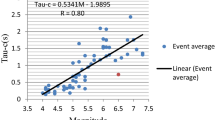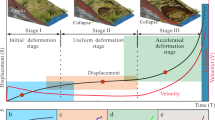Abstract
Landslide is a natural hazard that, next to earthquakes and floods, causes the largest damage to humans. Nowadays, experts take landslide events into serious consideration and they try to map and identify them accurately in time domain. So far, most of the methods used for this purpose have been of the time-domain type with their own drawbacks. Dealing with some functions in a time-domain method is difficult due to the complexity of calculations, frequency behavior analysis and content extraction. Therefore, a frequency-domain format was used in this study. The short-time Fourier transform and weighted overlay methods were applied in order to detect landslides-prone areas, and the results were evaluated using the prediction-area plot. As the intersection point of the P–A plot in the power spectrum-area model demonstrated 82% of landslide events had occurred only in 18% of the district, while the intersection point of the P–A plot in the weighted overlay model showed the occurrence of 70% of landslide events only in 30% of the study area.





Similar content being viewed by others
Availability of data and material
(It is possible to share data for anyone who makes a logical request).
Code Availability
(It is possible).
References
Aditian A, Kubota T, Shinohara Y (2018) Comparison of GIS-based landslide susceptibility models using frequency ratio, logistic regression, and artificial neural network in a tertiary region of Ambon, Indonesia, vol 318. Geomorphology, pp 101–111
Abdollahizad S, Balafar MA, Feizizadeh B, Sangar AB, Samadzamini K (2021) Correction to: Using hybrid artificial intelligence approach based on a neurofuzzy system and evolutionary algorithms for modeling landslide susceptibility in East Azerbaijan Province, Iran. Earth Sci Inf 14(4):1883–1883
Afzal P, Alghalandis YF, Khakzad A, Moarefvand P, Omran NR (2010) application of power spectrum-area fractal model to separate anomalies from background in Kahang Cu-Mo porphyry deposit, Central Iran. Arch Min Sci 55:389–410
Booth AM, Roering J, Perron J (2008) Automated Landslide Mapping Using Spectral Analysis and High-Resolution Topographic Data: Puget Lowlands, Washington, and Portland Hills, Oregon. AGUFM, 2008, pp. H43I-06
Cheng Q, Bonham-Carter GF, Agterberg FP, Wright DF (1994) Fractal modeling in the geosciences and implementation with GIS. In: Proc of the 6th Canadian conference on GIS, Ottawa, June 6–10, vol 1, pp 565–577
Cheng Q (1999) Multifractality and spatial statistics. Comput Geosci 25(9):949–961
Cheng Q, Xia Q, Li W, Zhang S, Chen Z, Zuo R, Wang W (2010) Density/area power-law models for separating multi-scale anomalies of ore and toxic elements in stream
Fallah-Zazuli M, Vafaeinejad A, Alesheykh AA, Modiri M, Aghamohammadi H (2019) Mapping landslide susceptibility in the Zagros Mountains, Iran: a comparative study of different data mining models. Earth Sci Inf 12(4):615–628
Ghiasi V, Ghasemi SAR, Yousefi M (2021) Landslide susceptibility mapping through continuous fuzzification and geometric average multi-criteria decision-making approaches. Nat Hazards 107(1):795–808
Heidari AA, Pahlavani P (2017) An efficient modified grey wolf optimizer with Lévy flight for optimization tasks. Appl Soft Comput 60:115–134
Karpatne A, Ebert-Uphoff I, Ravela S, Babaie HA, Kumar V (2018) Machine learning for the geosciences: Challenges and opportunities. IEEE Trans Knowl Data Eng 31(8):1544–1554
Luque-Espinar JA, Mateos RM, García-Moreno I, Pardo-Igúzquiza E, Herrera G (2017) Spectral analysis of climate cycles to predict rainfall induced landslides in the western Mediterranean (Majorca, Spain). Nat Hazards 89(3):985–1007
Malamud BD, Turcotte DL, Guzzetti F, Reichenbach P (2004) Landslide inventories and their statistical properties. Earth Surf Process Landf 29:687–711. https://doi.org/10.1002/esp.1064
Mokhtari AR (2014) Hydrothermal alteration mapping through multivariate logistic regression analysis of lithogeochemical data. J Geochem Explor 145:207–212
Mokhtari AR, Nezhad SG (2015) A modified equation for the downstream dilution of stream sediment anomalies. J Geochem Explor 159:185–193
Nezhad SG, Mokhtari AR, Rodsari PR (2017) The true sample catchment basin approach in the analysis of stream sediment geochemical data. Ore Geol Rev 83:127–134
Oveisi N, Moghani K, Bay N (2015) Landslide hazard zonation using bivariate statistical (AHP) model in Golestan Province. Q Sci J Rescue Relief 6(4):0–0
Oppenheim AV, Buck JR, Schafer RW (2001) Discrete-time signal processing, vol 2. Prentice Hall, Upper Saddle River, NJ
Park HJ, Jang JY, Lee JH (2017) Physically based susceptibility assessment of rainfall-induced shallow landslides using a fuzzy point estimate method. Remote Sensing, 9(5), p. 487
Perron JT, Kirchner JW, Dietrich WE (2008) Spectral signatures of characteristic spatial scales and nonfractal structure in landscapes. Journal of Geophysical Research: Earth Surface, 113(F4)
Rafiei Sardooi E, Azareh A, Mesbahzadeh T, Soleimani Sardoo F, Parteli EJ, Pradhan B (2021) A hybrid model using data mining and multi-criteria decision-making methods for landslide risk mapping at Golestan Province, Iran. Environ Earth Sci 80(15):1–25
Ren F, Wu X, Zhang K, Niu R (2015) Application of wavelet analysis and a particle swarm-optimized support vector machine to predict the displacement of the Shuping landslide in the Three Gorges, China. Environ Earth Sci 73(8):4791–4804
Shahrestani S, Mokhtari AR (2017) Dilution correction equation revisited: The impact of stream slope, relief ratio and area size of basin on geochemical anomalies. J Afr Earth Sc 128:16–26
Shirani, K, & Seif, A (2012) Landslide hazard zonation by using statistical methods (Pishkuh Region in Fereydonshahr Province). Journal of Geoscience, 22(85), 149–158.
Tsangaratos P, Loupasakis C, Nikolakopoulos K, Angelitsa V, Ilia I (2018) Developing a landslide susceptibility map based on remote sensing, fuzzy logic and expert knowledge of the Island of Lefkada, Greece. Environmental Earth Sciences, 77(10), p. 363
Xiong, DK, Liu, J, Shen, TL and Yin, Q (2005) Basic features of the Tiantai landslide in Xuanhan, Sichuan. Acta Geologica Sichuan, 25(3), pp.156–159.
Yousefi M, Kamkar-Rouhani A, Carranza EJM (2012) Geochemical mineralization probability index (GMPI): a new approach to generate enhanced stream sediment geochemical evidential map for increasing probability of success in mineral potential mapping. J Geochem Explor 115:24–35
Yousefi M, Carranza EJM, Kamkar-Rouhani A (2013) Weighted drainage catchment basin mapping of geochemical anomalies using stream sediment data for mineral potential modeling. J Geochem Explor 128:88–96
Yousefi M, Carranza EJM (2015a) Fuzzification of continuous-value spatial evidence for mineral prospectively mapping. Comput Geoscience 74:97–109
Yousefi M, Carranza EJM (2015b) geometric average of spatial evidence data layers: A GIS-based multi criteria decision making approach to mineral prospectively mapping. Comput Geoscience 83:72–79
Yousefi M, Carranza EJM (2015c) Prediction-area (P-A) plot and C-A fractal analysis to classify and evaluate evidential maps for mineral prospectivity modeling, vol 79. Computers & Geosciences, pp 69–81
Yousefi M, Nykänen V (2016) Data-driven logistic-based weighting of geochemical and geological evidence layers in mineral prospectivity mapping. J Geochem Explor 164:94–106
Yousefi M, Carranza EJM, Kreuzer OP, Nykänen V, Hronsky JM, Mihalasky MJ (2021) Data analysis methods for prospectivity modelling as applied to mineral exploration targeting: State-of-the-art and outlook. Journal of Geochemical Exploration, 229, p. 106839
Funding
(The authors did not receive support from any organization for the submitted work.)
Author information
Authors and Affiliations
Contributions
(We confirm that the manuscript has been read and approved by all named authors).
Ethics approval
(We the undersigned declare that this manuscript is original, has not been published before and is not currently being considered for publication elsewhere. We confirm that the manuscript has been read and approved by all named authors and that there are no other persons who satisfied the criteria for authorship but are not listed. We further confirm that the order of authors listed in the manuscript has been approved by all of us. We understand that the Corresponding Author is the sole contact for the Editorial process. She is responsible for communicating with the other authors about progress, submissions of revisions and final approval of proofs Signed by all authors).
Corresponding author
Ethics declarations
Consent to participate
(We confirm that the manuscript has been read and approved by all named authors).
Consent for publication
The authors have no relevant financial or non-financial interests to disclose.
I, the undersigned, give my consent for the publication of identifiable details, which can include photograph(s) and/or videos and/or case history and/or details within the text (“Material”) to be published in the above Journal and Article. I confirm that I have seen and been given the opportunity to read both the Material and the Article (as attached) to be published by Taylor & Francis. I have discussed this consent form with “Identify Landslide Risk Areas Via Short Time Fourier Transform”, who is an author of this paper.
I understand that all Taylor & Francis journals may be available in both print and on the internet, and will be available to a broader audience through marketing channels and other third parties. Therefore, anyone can read material published in the Journal. I understand that readers may include not only medical professionals and scholarly researchers but also journalists and general members of the public).
Conflicts of interest/Competing interests
(There is no conflict of interest).
Financial interests
The authors declare they have no financial interests.
Additional information
Communicated by H. Babaie
Publisher’s note
Springer Nature remains neutral with regard to jurisdictional claims in published maps and institutional affiliations.
Rights and permissions
About this article
Cite this article
Hoseinzade, Z., Mokhtari, M., Shirani, K. et al. Identification of areas at the risk of landslide via the short-time Fourier transform. Earth Sci Inform 15, 2405–2413 (2022). https://doi.org/10.1007/s12145-022-00816-5
Received:
Revised:
Accepted:
Published:
Issue Date:
DOI: https://doi.org/10.1007/s12145-022-00816-5




